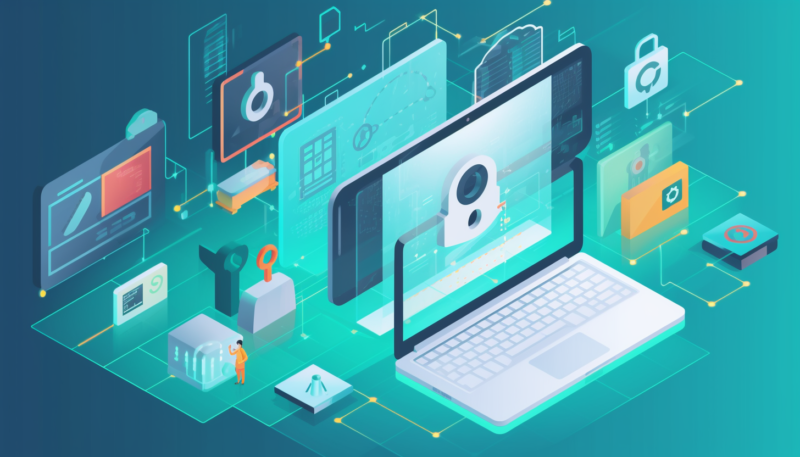Guide
In today’s digital age, where personal information is constantly being shared and stored online, ensuring your online privacy and data security has become more crucial than ever. Online privacy refers to the control you have over the information you share and who can access it, while data security involves protecting your sensitive data from unauthorized access or breaches. Here are some key reasons why online privacy and data security are important and How to secure your online privacy
- Protecting Personal Information: Online platforms collect vast amounts of personal information, including your name, address, contact details, and browsing habits. Maintaining privacy safeguards this sensitive information from falling into the wrong hands and reduces the risk of identity theft or fraud.
- Safeguarding Financial Details: When making online transactions or sharing financial information, such as credit card numbers or bank account details, ensuring privacy and data security is crucial. It prevents unauthorized individuals from accessing your financial information and helps prevent financial fraud.
- Preserving Reputation: Information shared online can have a lasting impact on your personal and professional reputation. By maintaining online privacy, you have more control over what others can see and minimize the risk of reputation damage or online harassment.
- Preventing Targeted Advertising and Tracking: Online platforms often track your online activities and use that data for targeted advertising. By protecting your online privacy, you can limit the amount of personal data collected and reduce intrusive advertisements and targeted marketing efforts.
Brief Overview of the Comprehensive Guide
This comprehensive guide aims to provide you with practical tips and strategies to enhance your online privacy and data security. It covers a wide range of topics, including:
- Understanding Online Privacy: Learn about the concept of online privacy, the potential risks and threats, and dispel common misconceptions.
- Assessing Your Current Privacy Status: Discover methods to evaluate your online presence, identify vulnerabilities, and conduct privacy audits to gauge your current privacy status.
- Enhancing Your Online Privacy: Explore various techniques to strengthen your online privacy, such as creating strong and unique passwords, implementing two-factor authentication, securing devices and networks, and managing social media privacy settings.
- Browsing the Web Anonymously: Gain insights into anonymous browsing, virtual private networks (VPNs), and the benefits of the Tor network.
- Safeguarding Your Digital Footprint: Learn how to manage cookies and browser tracking, clear browsing history and cache, and opt out of targeted advertising.
- Protecting Your Communication: Discover methods to secure your communication channels, including encrypted messaging apps, email security measures, and precautions against phishing attacks.
- Privacy on Social Media Platforms: Understand privacy settings on popular social media platforms and learn how to safeguard your personal information while using these platforms.
- Managing Online Accounts: Implement strong security measures for your online accounts, enable multi-factor authentication, and regularly review and update account settings.
- Mobile Privacy Best Practices: Discover strategies to secure your mobile devices, manage app permissions, and protect personal data on smartphones and tablets.
- Privacy Tips for Public Wi-Fi Networks: Learn about the risks associated with public Wi-Fi networks and adopt secure browsing practices to protect your privacy.
- Responding to Data Breaches and Identity Theft: Understand how to recognize signs of a data breach or identity theft, take immediate actions in case of a breach, and protect yourself from identity theft.
Definition of Online Privacy
Online privacy refers to the ability to control the collection, use, and sharing of personal information that is transmitted or stored online. It encompasses the right of individuals to determine what information they want to disclose, who can access it, and how it is used. Online privacy involves protecting sensitive data, maintaining confidentiality, and ensuring that individuals have control over their digital identities.
B. Risks and Threats to Online Privacy
- Data Breaches: Hackers and cybercriminals target organizations to gain unauthorized access to databases containing personal information. Data breaches can lead to the exposure of sensitive data, such as usernames, passwords, financial details, and personal records.
- Identity Theft: When personal information is compromised, cybercriminals can use it to impersonate individuals, commit financial fraud, or engage in illegal activities in their name. Identity theft can have severe consequences for victims, including financial loss and reputational damage.
- Phishing Attacks: Phishing involves fraudulent attempts to deceive individuals into revealing personal information, such as login credentials or credit card details, by posing as trustworthy entities. Phishing attacks are often conducted through deceptive emails, messages, or fake websites.
- Tracking and Profiling: Online platforms and advertisers collect data about users’ online activities to create profiles and deliver targeted advertisements. This tracking can lead to a loss of privacy and personalized manipulation of individuals’ preferences and behaviors.
- Social Engineering: Social engineering techniques exploit human psychology to deceive individuals into revealing sensitive information or performing actions that compromise their privacy and security. Techniques include impersonation, pretexting, and manipulation through phone calls or social media interactions.
Common Misconceptions
- “I have nothing to hide”: Many people believe that if they are not engaged in illegal activities, they have nothing to hide. However, online privacy is about maintaining control over personal information and protecting oneself from potential risks, regardless of whether the information is illegal or not.
- “Using incognito mode ensures privacy”: While using incognito or private browsing mode can prevent the browser from storing your browsing history locally, it does not guarantee complete anonymity. Other entities, such as internet service providers and websites you visit, can still track your activities.
- “Privacy settings are sufficient”: Relying solely on default privacy settings may not provide adequate protection. It is essential to review and customize privacy settings on various online platforms to limit the sharing of personal information and control who can access it.
- “Only strangers can pose a threat”: Online threats can come from both strangers and people known to you. It is crucial to be cautious about sharing personal information online and be aware of the potential risks posed by friends, acquaintances, or malicious insiders.
Assessing Your Current Privacy Status:
Before implementing measures to enhance your online privacy, it’s crucial to assess your current privacy status. By evaluating your online presence, identifying potential vulnerabilities, and conducting privacy audits, you can gain valuable insights into areas that require attention. Follow these steps to assess your privacy status effectively:
Evaluating your online presence:
- Review your online profiles: Assess the information available on your social media profiles, websites, and other online platforms.
- Search your name: Conduct a search engine query to see what information is associated with your name.
- Check public records: Verify if any public records or personal data are accessible online.
Identifying potential privacy vulnerabilities:
- Social media settings: Review your privacy settings on social media platforms to ensure they align with your desired level of privacy.
- Data sharing practices: Evaluate the type and amount of information you share online, including personal details, location, and photos.
- Third-party apps and services: Assess the permissions and access granted to third-party apps and services connected to your accounts.
Conducting privacy audits:
- Review account permissions: Regularly review and revoke unnecessary permissions granted to apps, websites, and services.
- Check privacy policies: Examine the privacy policies of platforms you use to understand how they handle your data.
- Monitor online presence: Set up alerts or use monitoring tools to receive notifications about mentions of your name or personal information online.
Enhancing Your Online Privacy:
Enhancing your online privacy is crucial in today’s digital landscape. By implementing various measures, you can strengthen the security of your personal information and reduce the risk of unauthorized access. Consider the following steps to enhance your online privacy:
Creating strong and unique passwords:
- Use a combination of uppercase and lowercase letters, numbers, and special characters.
- Avoid using easily guessable information like your name or birthdate.
- Use a different password for each online account to prevent a single breach compromising multiple accounts.
- Consider using a password manager to securely store and generate strong passwords.
Implementing two-factor authentication:
- Enable two-factor authentication (2FA) for your online accounts whenever possible.
- Two-factor authentication adds an extra layer of security by requiring a second verification step, such as a code sent to your phone.
- Use authentication apps or hardware tokens for 2FA instead of relying solely on SMS-based verification.
Securing your devices and networks:
- Keep your devices updated with the latest software and security patches.
- Use reputable antivirus software and regularly scan your devices for malware.
- Secure your home Wi-Fi network with a strong password and encryption.
- Avoid using public Wi-Fi networks for sensitive activities or use a virtual private network (VPN) for added security.
Managing and controlling social media privacy settings:
- Review and adjust privacy settings on social media platforms to limit the visibility of your personal information.
- Regularly review and update who can see your posts, photos, and personal details.
- Be cautious about accepting friend requests or connections from unknown individuals.
Protecting your personal information online:
- Be mindful of the information you share online, both publicly and privately.
- Be cautious when sharing personal details, financial information, or sensitive data.
- Avoid oversharing on social media and be wary of phishing attempts or scams that may trick you into revealing personal information.
Managing Online Accounts:
Managing your online accounts effectively is essential for maintaining strong security and protecting your personal information. By implementing the following practices, you can enhance the security of your accounts and minimize the risk of unauthorized access:
Implementing strong account security measures:
- Choose unique and complex passwords for each of your online accounts.
- Avoid using easily guessable information or common passwords.
- Consider using a password manager to securely store and manage your passwords.
- Regularly change your passwords, especially after a security breach or if you suspect any unauthorized activity.
Enabling multi-factor authentication for online accounts:
- Enable multi-factor authentication (MFA) whenever possible.
- MFA adds an extra layer of security by requiring an additional verification step, such as a code sent to your phone or biometric authentication.
- Use authenticator apps or hardware tokens for MFA, as they provide more secure options than SMS-based verification.
Regularly reviewing and updating account settings:
- Periodically review the privacy and security settings of your online accounts.
- Check the access permissions granted to third-party applications and services.
- Disable or remove any unused accounts to minimize the potential attack surface.
- Stay informed about any security updates or alerts from the service providers.
Responding to Data Breaches and Identity Theft:
Data breaches and identity theft can have severe consequences for your online privacy and security. It’s crucial to know how to recognize the signs of a breach, take immediate action, and protect yourself from identity theft. Here are the steps you should follow:
Recognizing signs of a data breach or identity theft:
- Monitor your financial statements for any unauthorized transactions or unusual activity.
- Pay attention to notifications or alerts from service providers about potential data breaches.
- Be vigilant for signs of identity theft, such as unexpected credit inquiries or unfamiliar accounts.
Taking immediate actions in case of a breach:
- Change your passwords for the affected accounts immediately.
- Notify the relevant service provider about the breach and follow their recommended steps.
- Monitor your credit reports regularly and consider placing a fraud alert or credit freeze if necessary.
- Report the incident to the appropriate authorities, such as your local law enforcement or the Federal Trade Commission (FTC).
Protecting yourself from identity theft:
- Use strong and unique passwords for all your online accounts.
- Be cautious about sharing personal information online and only provide it to trusted sources.
- Regularly review your financial statements and credit reports for any suspicious activity.
- Consider using identity theft protection services or credit monitoring tools for added security.
Conclusion:
In conclusion, securing your online privacy and protecting your personal information are crucial in today’s digital landscape. This comprehensive guide has covered various aspects of online privacy, including understanding its importance, assessing your current privacy status, enhancing privacy measures, browsing the web anonymously, safeguarding your digital footprint, and managing online accounts.
Additionally, we discussed best practices for mobile privacy, tips for using public Wi-Fi networks securely, and how to respond to data breaches and identity theft. By following the recommendations outlined in this guide, you can significantly improve your online privacy and reduce the risk of unauthorized access or data breaches.
Remember, prioritizing online privacy is an ongoing effort. Stay informed about the latest security practices, regularly review and update your privacy settings, and remain vigilant against potential threats. By implementing these measures and adopting a proactive approach to online privacy, you can enjoy a safer and more secure digital experience.









